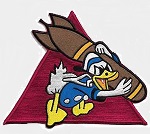Hobby Master HA4210 US Army Air Force Douglas A-20G Havoc Medium Bomber - "Little Joe", 389th Bombardment Squadron, 312th Bombardment Group, 5th Air Force, Early 1945 (1:72 Scale)
"Thanks to its 2,400 hp engine it had a considerable margin of excess power and its acceleration was phenomenal. It was pretty tricky to fly, but its performance more than made up for it..."
- French ace Pierre Clostermann, from his book "The Big Show"
 The Douglas A-20/DB-7 Havoc was a family of American attack, light bomber and night fighter aircraft of World War II, that served with several Allied air forces, principally those of the Soviet Union, United Kingdom, and United States. The DB-7 was also used by the air forces of Australia, South Africa, France, and the Netherlands during the war, and Brazil afterwards. The bomber aircraft was known as Boston among British and Commonwealth air forces, while the Royal Air Force night fighter variants were given the service name Havoc. The United States Army Air Forces assigned the DB-7 the designation "A-20" and gave it the popular name "Havoc".
The Douglas A-20/DB-7 Havoc was a family of American attack, light bomber and night fighter aircraft of World War II, that served with several Allied air forces, principally those of the Soviet Union, United Kingdom, and United States. The DB-7 was also used by the air forces of Australia, South Africa, France, and the Netherlands during the war, and Brazil afterwards. The bomber aircraft was known as Boston among British and Commonwealth air forces, while the Royal Air Force night fighter variants were given the service name Havoc. The United States Army Air Forces assigned the DB-7 the designation "A-20" and gave it the popular name "Havoc".
The A-20J carried an additional bombardier in an extended acrylic glass nose section. These were intended to lead bombing formations, with the following standard A-20s dropping their bombs when signaled by the leader. A total of 450 were built, 169 for the RAF which designated them Boston Mk IV from the summer of 1944 onwards.
This particular 1:72 scale replica of a US Army Air Force Douglas A-20G Havoc medium bomber was nicknamed "Little Joe" and was attached to the 389th Bombardment Squadron, 312th Bombardment Group, 5th Air Force, during early 1945.
Sold Out!
Dimensions:
Wingspan: 8-1/4-inches
Length: 11-3/4-inches
Release Date: May 2020
 Historical Account: "Little Joe" - Flown by the Allies in the Pacific, the Middle East, North Africa, Europe and Russia, the versatile A-20 went through many variants. The A-20G, which reached combat in 1943, was produced in larger numbers than any other model. By the time production ended in September 1944, American factories had built 2,850 "solid nose" A-20G models. Attacking with forward-firing .50-cal. machine guns and bombs, the A-20G lived up to its name by creating havoc and destruction on low-level strafing attacks, especially against Japanese shipping and airfields across the Southwest Pacific.
Historical Account: "Little Joe" - Flown by the Allies in the Pacific, the Middle East, North Africa, Europe and Russia, the versatile A-20 went through many variants. The A-20G, which reached combat in 1943, was produced in larger numbers than any other model. By the time production ended in September 1944, American factories had built 2,850 "solid nose" A-20G models. Attacking with forward-firing .50-cal. machine guns and bombs, the A-20G lived up to its name by creating havoc and destruction on low-level strafing attacks, especially against Japanese shipping and airfields across the Southwest Pacific.
In 1961, the Bankers Life and Casualty Co. of Chicago, Ill., donated an A-20G to the museum. It is painted to represent "Little Joe" of the 389th Bomb Squadron, 312th Bomb Group, 5th Air Force, with 150 missions.
Originally trained to fly P-40s, the men of the 312th transitioned to the A-20G in the field. Calling themselves the "Roarin' 20s," the men of the 312th fought their way across the Southwest Pacific from New Guinea to the Philippines. (courtesy National Museum of the United States Air Force)


